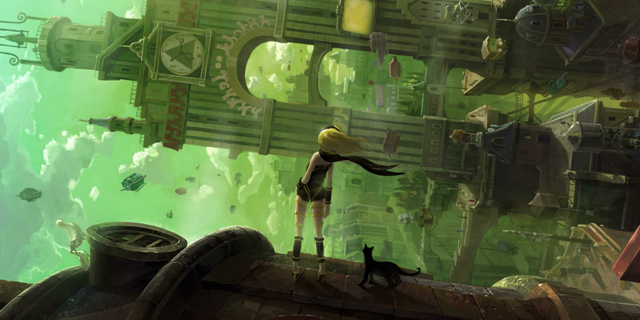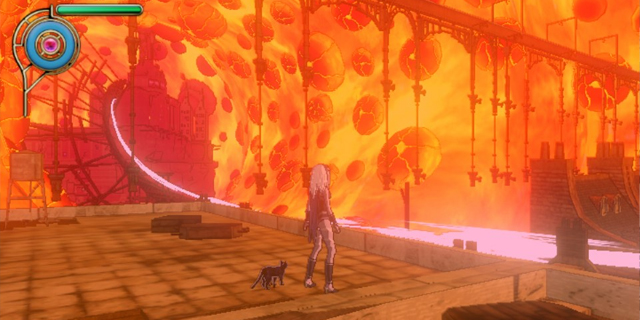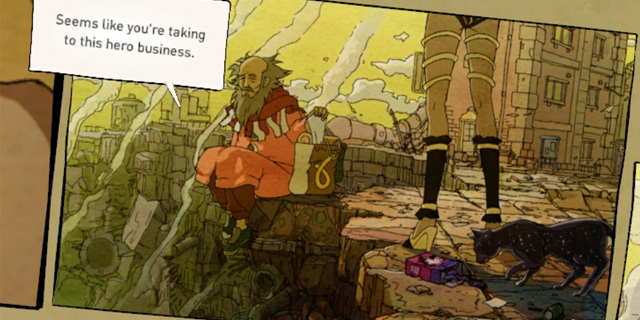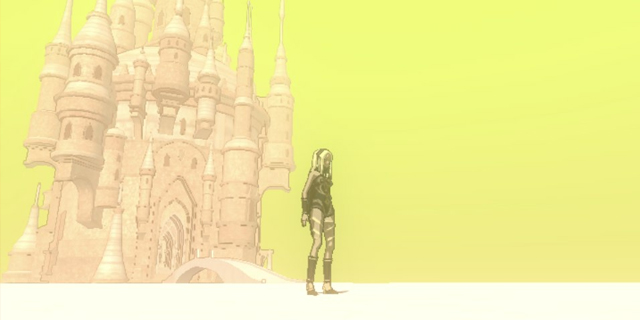
It doesn’t take a genius to see that Sony’s new PlayStation Vita is going through a rough patch as of now. Low sales and waning interest in the handheld make it a tough sell for the time being. Sony intends to ease this software dry spell with its own Gravity Rush, a sandbox game meant to demonstrate the Vita’s graphical capabilities and input options. Is Gravity Rush enough of a winner to carry the new system into prosperity, or does it fall flat on its face?
I’m going to go ahead and say the inevitable, so I won’t be beating around the bush later: Gravity Rush’s gameplay simply doesn’t work. It shows tremendous promise, and at times it even follows through on it, but for the most part, the game is weighed down by clunky controls, an uncooperative camera and unresponsive controls. The idea of effortlessly flying around a vast cityscape by shifting gravity at will is a fantastic idea, and one I hope gets revisited later in another game, but the concept is bungled here. As opposed to the intuitive gravity play of a game such as Super Mario Galaxy, Gravity Rush complicates matters with its controls and bizarre physics algorithms.
Allow me to elaborate, starting with the gravity shifting itself. The floating, multi-layered cities in Gravity Rush are meant to encourage and emphasize the use of your gravity-shifting powers, but most of the time, it feels like a perplexing maze. Flying over the world with no intended direction, however, is a great deal of fun, and provides some impressive visual experiences. But, most of the time, you’ll just be rushing from A to B. The disorienting camera becomes a big problem during boss fights, where you have to constantly shift gravity multiple times over a short span of time. It can easily get stuck on terrain or consistently show you a misleading view.

As a sandbox game, side missions should be the bread and butter of the genre. Not so in Gravity Rush. In fact, speaking relatively, there is hardly anything in the way of extra stuff to do outside the main story, and the missions you do get are often repeats of the same mission in a new area. I am sure I could count the number of unique side quests on two hands. This is bad news for anyone looking to get several hours of playtime out of the game, as once you are finished with the story missions, all you can do is try and get better scores. If you were expecting the depth and options of its contemporaries (like inFamous or Prototype), you will be sorely disappointed. Even the story itself is short, weighing in at a paltry 21 missions. Even on a technical level, the game is faulty, often subject to terrible bouts of lag, at times when there should not be any.
The combat is a total chore. Speaking practically, there is really only one attack in the game, the gravity kick: A kick performed while suspended in midair that controls like a hurled brick. Sure, there are ground kicks, but they do little damage and are out of the range of most walking enemies, and obviously ineffective against flying enemies. There are also special attacks, which do little more damage than just a succession of normal kicks. In the end, combat will always follow the same pattern of retreating, waiting for your target to stop, aiming your trajectory, kicking and praying they don’t move out of the way in time.

Gravity Rush‘s story does not fare all that much better. Since the game itself does not last for nearly as long as it should, the story feels truncated, like this is an abridged version of a full game. On the bright side, there are plenty of interesting characters, but not a single one is ever fully developed, realized or even explained. I was left curious as to the back stories of these characters, especially the main character herself. Many of this information would have benefited the plot immensely, but it is never divulged, resulting in a cast that leaves the player more annoyed than anything. I did not care about any of these characters, but both I and the game desperately wanted me to. The plot progression is far too harried to be enjoyable, filled with blink-and-you’ll-miss-it story events and characters, almost all of which are not given enough screen time to make any sort of impression (much less advance the story).
Things really only start to get interesting at the very end of the game, and not because the story straightens up, but instead because the action finally becomes more integrated into the narrative than before, creating excitement and tension. It seems like every mission introduces a new critical plot point that should carry the story for the next couple chapters, but without fail, it is always discarded at the end of the level. I am disappointed with Gravity Rush’s story not because it is lackluster or lazy; quite the opposite. I am disappointed because it establishes the cornerstones for a compelling, rich narrative, and then never get around to following through on the promise. Gravity Rush is a game packed to the brim with ideas, not a single one of which is used to its full potential.

Not all is doom and gloom, however. The game does have one redeeming quality that has so far been universally praised: its imaginatively-crafted aesthetic. Using cel-shading, Gravity Rush is able to present a world that is – stylistically – equal parts European art deco and modern comic book, making for a unique and eye-catching art style. The game seems to derive its color palette from the former, opting for heavy use of browns, reds, blacks, and yellows to reflect its French steampunk setting. The narrative presentation, however, relies on the latter, displaying cutscenes in comic panels, and using one of the more interesting visual tricks in the game.
By moving your Vita around during these cutscenes, the background, foreground, and speech bubbles will all move independently, creating a pseudo-3D effect. It obviously does not look as convincing as the 3DS, but it is still a nice piece of visual flair that adds character, and suits the tone of the game’s action quite well. The composition of each panel is thoughtfully-drawn, giving weight to the notion that this game may have been more at home on the medium of a graphic novel, not to mention that the game clearly has more to show than to do. To be honest, the majority of the fun from Gravity Rush comes from seeing what exotic location you will visit next. The fidelity is just as impressive, with detail rivaling and even besting many of the early PlayStation 3 titles by using the clean, line-focused look that cel-shading excels at, combined with already intricate character designs.
The soundtrack for Gravity Rush is a bit unexpected, carrying several heavily melody-focused, almost cartoony tracks. It was a bit of a jarring contrast in tone, using energetic orchestral tracks against the aforementioned neo-retro visual aesthetic. The soundtrack feels very similar to, well, Super Mario Galaxy. I hate to draw more comparisons than necessary to a similar game, but that is the best analog I can think of. This doesn’t make the soundtrack poor by any stretch of the imagination, however. It just doesn’t ever feel like it suits the mood as well as it should.
Gravity Rush is something of a small tragedy; one of the most hyped Vita games that has come along since launch, and one that was meant to give a healthy boost to system sales, sporting a top-notch visual and aural presentation, marred beyond repair by clunky, boring gameplay and a mishandled story. It’s games like this that just make me feel let down. A good concept should always deserve a quality game to accompany it and guide it to fruition. Unfortunately, this is one that is going to have to remain a missed opportunity.
Pros: Excellent visual presentation and soundtrack.
Cons: Haphazard story implementation, boring combat, unrealized characters



















